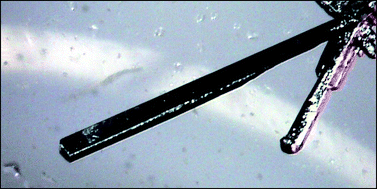A crystallic silver amalgam was found to be a suitable working electrode material for voltammetric determination of electrochemically reducible organic nitro-compounds. Optimum conditions for crystal growth were found, the crystal surface was investigated by atomic force microscopy in tapping mode and single crystals were used for the preparation of quasi-cylindrical single crystal silver amalgam electrode (CAgAE). An electrochemical behavior of this alternative electrode material was investigated in aqueous media by direct current voltammetry, cyclic voltammetry (CV), differential pulse voltammetry (DPV) and adsorptive stripping voltammetry (AdSV) using 4-nitrophenol as a model compound. Applicable potential windows of the CAgAE were found comparable with those obtained at a hanging mercury drop electrode, providing high hydrogen overpotential, and polished silver solid amalgam electrode. Thanks to the smooth single crystal electrode surface, the effect of the passivation is not too pronounced, direct DPV determination of 100 μmol l−1 of 4-nitrophenol at CAgAEs in 0.2 mol l−1 acetate buffer pH 4.8 provides a RSD around 1.5% (n = 15). DPV calibration curves of 4-nitrophenol are linear in the whole concentration range 1–100 μmol l−1 with a limit of quantification of 1.5 μmol l−1. The attempt to increase sensitivity by application of AdSV was not successful. The mechanism of 4-nitrophenol reduction at CAgAE was investigated by CV.

You have access to this article
 Please wait while we load your content...
Something went wrong. Try again?
Please wait while we load your content...
Something went wrong. Try again?


 Please wait while we load your content...
Please wait while we load your content...